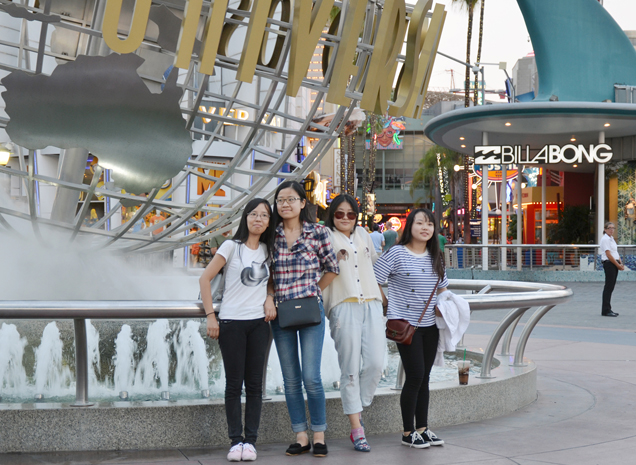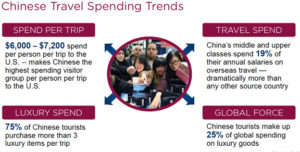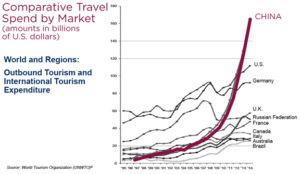Fight or go Shopping? China and America Can’t Decide

Chinese tourists relax at Universal Studios in Los Angeles’ San Fernando Valley
It’s been a long time since China and the U.S. were as close as lips and teeth. When Chinese president Xi Jinping arrives in Washington DC this week he will find barely disguised outrage over Beijing’s suspected cyber attacks, its terraforming in the South China Sea and the recent mass incarceration of human rights activists.
For its part, China is utterly convinced the U.S. is pursuing a policy of containment. In a recent Harvard University study, former Australian prime minister and China scholar Kevin Rudd summarized Beijing’s concerns in five bullet points: “to isolate China, contain it, diminish it, internally divide it and sabotage its political leadership.”
David Lampton, a professor at Johns Hopkins University’s School of Advanced International Studies believes Beijing and Washington are approaching a fork in the diplomatic road. “Our respective fears are nearer to outweighing our hopes than at any time since normalization,” he says.
Well, perhaps. China’s currency devaluation and the plummeting Shanghai stock exchange might presage a weakened global economy. Maybe five Chinese warships off the Alaskan coast and U.S. military advisors dispatched to the Philippines really means winter is coming. But out here in California, where nearly 15% of the population is Asian, it’s still Indian Summer and geo-strategy and political bluster take a back seat to a boom in trans Pacific travel and investment.
There were no discouraging words voiced at a recent U.S.-China Travel Leaders Summit in Los Angeles. Presentations focused on the growing numbers of Chinese traveling overseas and the vast amounts of currency they are spending.
 Devaluation may have affected yen and euro traders, but in the U.S., where the renminbi is pegged to the dollar, the yuan has lost only 0.8% of its value and devaluation has had no discernible impact on Chinese travel or leisure spending. “Every Chinese tourist who comes to America spends between $6,000 to $7,000 on average,” says Michael Merner, the Asia-based Managing Director of Brand USA, a public-private partnership created to promote America as a destination. “Our research shows that Chinese travel to the U.S. with the intention of spending 19% of their take-home pay. Chinese account for 25% of the global spending on luxury goods.”
Devaluation may have affected yen and euro traders, but in the U.S., where the renminbi is pegged to the dollar, the yuan has lost only 0.8% of its value and devaluation has had no discernible impact on Chinese travel or leisure spending. “Every Chinese tourist who comes to America spends between $6,000 to $7,000 on average,” says Michael Merner, the Asia-based Managing Director of Brand USA, a public-private partnership created to promote America as a destination. “Our research shows that Chinese travel to the U.S. with the intention of spending 19% of their take-home pay. Chinese account for 25% of the global spending on luxury goods.”
The reciprocal increase in travel between the U.S. and China results from a November 2014 agreement between Barack Obama and Xi Jinping that allows citizens of both countries to receive a ten-year visa to the other. Since the agreement was signed ten months ago, about 2.3 million tourist visas to the U.S. have been issued in China – one quarter of the global total. Demand for visas is so strong that the U.S. State Department recently dispatched 300 temporary duty consular officials to China to process the flow of paper. According to the National Travel and Tourism Office in Washington DC, Chinese arrivals to the U.S. will double by 2019 to more than 5,000,000.
America’s large cities and its National Park Service are gleefully gearing up for the influx. Los Angeles’ China-Ready Program prepares hotels, restaurants, markets and museums to be good hosts. To receive the China-Ready designation businesses must print guest information in Chinese, accept China UnionPay credit or debit cards and offer amenities such as slippers, hot water and Chinese tea in guest rooms. The city also encourages hotels to employ a Mandarin speaking staff, offer Chinese language newspapers and to have a Weibo or WeChat social media account.
“China is our top overseas market and we want to make Chinese visitors feel comfortable, which is why we created our China Ready program” says Kathryn Smits, the Los Angeles Tourism & Convention Board’s Vice President of International Tourism. “The fact is that Chinese visitors have a significant impact on LA’s economy and we are working to ensure our partners are prepared for the opportunity.”
Beijing may not want “Western influences” creeping into its society but it welcomes American visitors and encourages them to explore beyond Beijing, Shanghai and Guangzhou. “China has hundreds of beautiful villages, many of then 2,000 years old,” says Li Jinzao, Chairman of the China National Tourism Administration, “and we are busy improving facilities so they can welcome foreign guests,”
Based on presentations made to American travel agents and suppliers, China is serious about spreading its Western tourism bounty to rural areas. Hebei, Jilin and Xinjiang, an area that once required a special permit to visit, were the provinces China chose to feature. “You must buy our frog ovary oil when you come to Jilin,” confided provincial tourism director Zhao Xiaijun. “It makes all women prettier.”
tourism bounty to rural areas. Hebei, Jilin and Xinjiang, an area that once required a special permit to visit, were the provinces China chose to feature. “You must buy our frog ovary oil when you come to Jilin,” confided provincial tourism director Zhao Xiaijun. “It makes all women prettier.”
Difficult issues will continue to divide China and the U.S., but in the future problems may be easier to resolve because of the growing number of links between the countries. Every week, 340 wide-bodied aircraft have the capacity to carry 24,000 passengers between the U.S. and China. Seven gateway cities in China now connect directly to 13 U.S. destinations. Despite a 35% increase in airlift capacity from China to the U.S. this year alone, new flights continue to be added on a monthly basis. Demand is so vast that traffic is expected to triple by 2021
This is good news for LA Tourism. “Ten years ago, China barely registered in our data base,” says Ernest Wooden, president and CEO of the Los Angeles Tourism & Convention Board. “But last year 686,000 Chinese came to LA and spent $1.2 billion,” he smiles. “That makes China Number One in our book.”![]()

